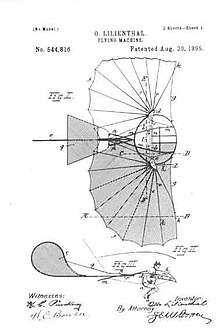Lilienthal Normalsegelapparat
The Lilienthal Normalsegelapparat (German: "Normal soaring apparatus") is a glider designed by Otto Lilienthal in Germany in the late 19th century. It is considered to be the first aeroplane to be serially produced, examples being made between 1893 and 1896.
| Normalsegelapparat | |
|---|---|
 | |
| Lichterfelde (near Berlin), 29 June 1895 | |
| Role | Glider |
| National origin | Germany |
| Manufacturer | Otto Lilienthal |
| Designer | Otto Lilienthal |
| First flight | 1893 |
| Number built | 10 |
Nine examples are known to have been sold, the buyers including Nikolai Zhukovsky and William Randolph Hearst. Three original "normal gliders" are preserved in museums in (London, Moscow, and Washington[1]), and a fragment of one is preserved in Munich. A similar glider, the Sturmflügelapparat ("storm wing apparatus") is preserved in the Technisches Museum in Vienna.
Lilienthal's flights using this glider typically achieved a distance of 250 m (820 ft) starting from the top of the launching mound that he had constructed. A bow frame or "Prellbügel" was used to reduce the impact in case of a crash. Later the Normalsegelapparat was developed into a biplane.
An authentic replica of the Normalsegelapparat made by the Otto Lilienthal Museum have been investigated by the German Aerospace Center in wind tunnel and flight tests. The results proof that the glider was stable in pitch and roll and can be flown safely at moderate altitudes.[2][3]
Specifications (typical)

Data from [5]
General characteristics
- Crew: One
- Length: 5.30 m (17 ft 5 in)
- Wingspan: 6.70 m (22 ft 0 in)
- Wing area: 13.6 m2 (146 sq ft)
- Empty weight: 20 kg (44 lb)
Performance
- Maximum glide ratio: 4[2]
References
- John R. Dailey; John H. Glenn, Jr. Smithsonian National Air and Space Museum: An Autobiography. p. 46.
- Raffel, Markus; Wienke, Felix; Dillmann, Andreas (July 2019). "Flight Testing Stability and Controllability Otto Lilienthal's Monoplane Design from 1893". Journal of Aircraft. 56 (4): 1735–42. doi:10.2514/6.2019-2815.
- Video of the first flight of the replica of Otto Lilienthal’s biplane glider Retrieved: 15. Febr. 2020.
- US Patent No. 544816
 Markus Raffel German Aerospace Center (DLR) flying an authentic replica of the Normalsegelapparat at the Californian coast in 2019
Markus Raffel German Aerospace Center (DLR) flying an authentic replica of the Normalsegelapparat at the Californian coast in 2019 - Nitsch: Die Flugzeuge von Otto Lilienthal. Anklam 2016. ISBN 978-3-941681-88-0
Bibliography
- Nitsch, Stephan. Vom Sprung zum Flug (From the jump to the flight). Berlin, Brandenburgisches Verlagshaus, 1991. ISBN 3-327-01090-0. Modified second edition: Die Flugzeuge von Otto Lilienthal. Technik - Dokumentation - Rekonstruktion. (The airplanes of Otto Lilienthal. Technique - Documentation - Reconstruction). Otto-Lilienthal-Museum Anklam, 2016. ISBN 978-3-941681-88-0.